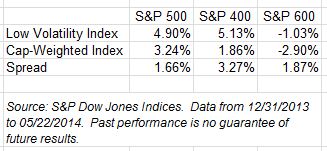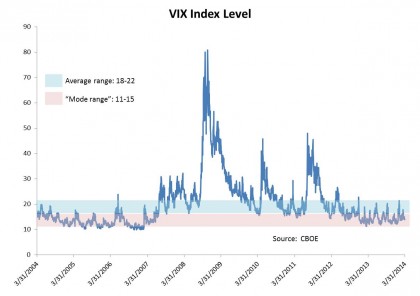It’s hot out there in India. Is it because of the peak of summer? Or because of the Modi swearing in as a PM? Or because of the S&P BSE SENSEX is reaching new highs in the past few weeks? On May 9, 2014, the index reached another new, all-time high of 23,048.49 (price return index). The S&P BSE SENSEX, India’s most-tracked bellwether index, is designed to measure the performance of the 30 largest, most-liquid and financially sound companies across key sectors of the Indian economy that are listed on the BSE Ltd. The index is also regarded as the pulse of the Indian capital market across the world. The question arises here; does the S&P BSE SENSEX really reflect the performance of the Indian capital market? Let’s check this out. The S&P BSE 500, which is one of the broadest market indices in the S&P BSE Index Family, covers roughly 95% of the total listed market capitalization on the BSE Ltd. Thus, we can safely use the S&P BSE 500 as a proxy for the Indian capital market. The S&P BSE SENSEX comprises only 30 stocks and covers close to 50% of the total listed market capitalization on BSE Ltd.
| Exhibit 1: Total Market Capitalization Coverage | ||
| Indices/Exchange | Total Market Capitalization (INR Billion) | Coverage (%) |
| S&P BSE SENSEX | 37,059.42 | 49 |
| S&P BSE 500 | 71,138.43 | 95 |
| BSE Ltd. | 74,947.91 | 100 |
Source: S&P Dow Jones Indices and BSE Ltd. Data as of April 30, 2014. Exhibit 2 shows annualized returns and annualized risk (risk measured in standard deviation) over the past one-, three- and five-year periods. The Exhibit confirms the fact that the S&P BSE SENSEX and the S&P BSE 500 have similar risk/return profiles. Over the past five years, the S&P BSE SENSEX has posted a risk-adjusted returns ratio of 0.76 (which means 0.76% of returns earned per unit of risk taken), while the S&P BSE 500 has posted a slightly lower (but similar) risk-adjusted return ratio of 0.73.
| Exhibit 2: Index Performance (Return and Risk) | ||||||
| Period | S&P BSE SENSEX (TR) | S&P BSE 500 (TR) | ||||
| Return (%) | Risk (%) | Risk Adjusted Return Ratio | Return (%) | Risk (%) | Risk Adjusted Return Ratio | |
| 1-Year | 17 | 13 | 1.26 | 15 | 16 | 0.95 |
| 3-Year | 7 | 16 | 0.43 | 6 | 18 | 0.31 |
| 5-Year | 16 | 21 | 0.76 | 17 | 23 | 0.73 |
Source: S&P Dow Jones Indices. Data as of April 30, 2014. Calculations are based on total return index levels in INR. As shown in Exhibit 3, the S&P BSE SENSEX and the S&P BSE 500 have fairly similar distributions across all sectors of the Indian capital market. Financials comprises the highest proportion of the S&P BSE SENSEX (27.6%) and the S&P BSE 500 (25.6%); while a telecommunication service carries the lowest proportion of the indices (2% of the S&P BSE SENSEX and 2.2 % of the S&P BSE 500). Other sectors follow a similar pattern, with similar weights in both of the indices.
| Exhibit 3: Sector Composition of S&P BSE Indices | ||
| Sector | S&P BSE SENSEX (%) | S&P BSE 500 (%) |
| Consumer Discretionary | 10.7 | 10.6 |
| Consumer Staples | 11.9 | 10.9 |
| Energy | 13.0 | 9.6 |
| Financials | 27.6 | 25.6 |
| Health Care | 5.5 | 6.9 |
| Industrials | 6.3 | 8.6 |
| Information Technology | 16.5 | 13.1 |
| Materials | 3.6 | 8.8 |
| Telecommunication Services | 2.0 | 2.2 |
| Utilities | 2.9 | 3.7 |
| Total | 100.0 | 100.0 |
Source: S&P Dow Jones Indices. Data as of April 30, 2014.
The posts on this blog are opinions, not advice. Please read our Disclaimers.















































